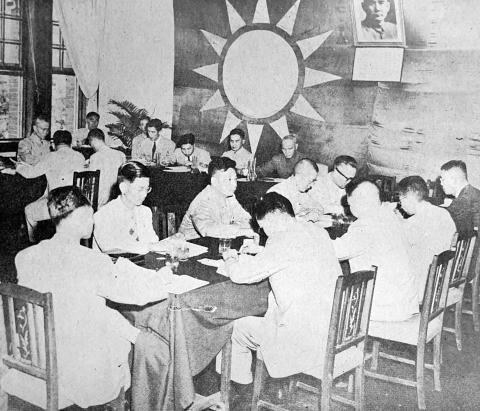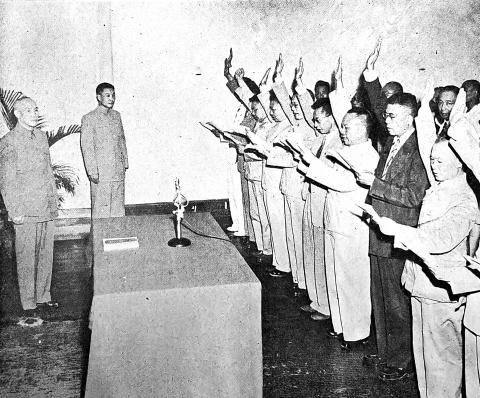Jan. 20 to Jan. 26
Party members calling for the Chinese Nationalist Party (KMT) to reform after last week’s elections have been using the word gaizao (改造) — the exact same phrase the party used 70 years ago for its two-year restructuring plan.
Although using the same word, the nature and circumstances of the two events are vastly different. In 1950, the KMT had just retreated to Taiwan after losing the Chinese Civil War, and its leader Chiang Kai-shek (蔣介石) has just resumed his presidency on March 1.

Photo courtesy of National Central Library
Chen Sheau-huey (陳曉慧) writes in “Revolution from the top down: a study on the reform of Kuomintang” (由上而下的革命:中國國民黨改造之研究), “After losing China, could the KMT discard its old baggage, shed its weak and corrupt image and create a new opportunity to oppose the communists and reclaim their country?” The KMT even considered changing its name to signal a new beginning at one point, but ultimately decided not to.
Chen writes that historians generally offer two different takes on the results. One side states that the restructuring process gave the KMT new life to secure its footing in Taiwan, and using the island as a centralized base, the party was able to build Taiwan’s economy and launch it to prosperity. Critics, however, say that it merely led to a redistribution of power within the KMT that allowed Chiang to rule Taiwan as a strongman.
Nevertheless, “by the end of the process in October 1952, the reformed KMT essentially had complete control over the Republic of China government as well as Taiwan,” Chen writes.

Photo courtesy of National Central Library
NEED FOR CHANGE
Chiang originally drafted the party restructuring plan in July 1949 to better deal with the ongoing Chinese Civil War, but after the KMT’s expulsion from China, he had to reconsider the entire operation. A new plan was devised in January 1950.
By then, the Korean War was underway and the US had changed its policy on not helping Taiwan, sending the Taiwan Patrol Force to keep both sides from attacking each other. Chiang took this lull in action to launch the plan.
Chiang notes in the plan’s introduction that this would be the KMT’s sixth such restructuring, the first taking place in 1914 when founder Sun Yat-sen (孫逸仙) established the Chinese Revolutionary Party in exile after the demise of the Nationalist Party.
“In the past 40 years, every time our country’s survival and the success of our national revolution was at stake, we dedicated ourselves to party reform,” he writes.
Aside from internal instability caused by government misrule after World War II and the massive influx of refugees from China, the party was also plagued by infighting that intensified after World War II. Chen lists four major factions within the party when the reform began, most notably the CC Clique led by brothers Chen Kuo-fu (陳果夫) and Chen Li-fu (陳立夫), whose uncle was an early mentor of Chiang. The KMT believed that internal discord, in addition to disconnect with the general populace, was the main reason they lost the Chinese Civil War.
On Aug. 5, 1950, the 16-person restructuring committee began its work. Chen writes that the committee was made up of relatively young and well-educated party members with close ties to Chiang, including then-premier Chen Cheng (陳誠) and Chiang’s son, Chiang Ching-kuo (蔣經國).
In September, the KMT announced its updated political objectives: “To reform the organization of the party, to establish discipline within the party, to change the party’s operational methods, and transform the party into a powerful fighting body that carried out the Three Principles of the People,” as well as “stabilizing and developing Taiwan.”
TOTAL CONTROL
First was the reorganizing of party members. KMT members who came from China needed to re-register, undergo re-education and swear loyalty to Chiang, and were then organized into about 30,000 small groups that averaged six members each.
These small groups were required to hold meetings twice a week, study party ideals and work closely with the people. Starting in 1951, they were assigned different segments of society — peasants, workers, youth, Aboriginals, urban dwellers, and so on, and carried on their tasks among the ordinary populace while spreading the party’s influence.
The KMT also started actively recruiting. In 1950, it gained almost 28,000 new members, 36.7 percent of them under 25 years old and 60 percent Taiwanese. Many underwent “training” through touring programs organized by the Institute of Revolutionary Practice (革命實踐研究院), with the main purpose to strengthen their loyalty to the party and Chiang.
Meanwhile, Chiang looked to stop the rampant factionalism. Shut out of the restructuring process and at odds with Chen Cheng, Chen Li-fu moved his family to the US (reportedly under Chiang’s suggestion), remaining there for 18 years. Chen Kuo-fu was already ill and died in 1951. Chiang managed to subdue most of the other cliques this way by removing their leaders from power and having the members swear loyalty to him. This endeavor was not entirely successful, but at least nobody openly opposed Chiang anymore.
The restructuring and training programs to bolster KMT loyalty also took place in the military and secret intelligence service. The party also organized groups for students, laborers, farmers and women to further its reach. During this time, the KMT also exerted influence over the cultural sphere through censorship and programs that promoted patriotic and anti-communist literature.
Taiwan was already under martial law by then, and coupled with the Temporary Provisions Effective During the Period of National Mobilization for Suppression of the Communist Rebellion (動員戡亂時期臨時條款), Chiang effectively secured his position as the undisputed leader of a one party-state that tightly controlled the government, military and society.
Taiwan in Time, a column about Taiwan’s history that is published every Sunday, spotlights important or interesting events around the nation that have anniversaries this week.

Many people noticed the flood of pro-China propaganda across a number of venues in recent weeks that looks like a coordinated assault on US Taiwan policy. It does look like an effort intended to influence the US before the meeting between US President Donald Trump and Chinese dictator Xi Jinping (習近平) over the weekend. Jennifer Kavanagh’s piece in the New York Times in September appears to be the opening strike of the current campaign. She followed up last week in the Lowy Interpreter, blaming the US for causing the PRC to escalate in the Philippines and Taiwan, saying that as

This year’s Miss Universe in Thailand has been marred by ugly drama, with allegations of an insult to a beauty queen’s intellect, a walkout by pageant contestants and a tearful tantrum by the host. More than 120 women from across the world have gathered in Thailand, vying to be crowned Miss Universe in a contest considered one of the “big four” of global beauty pageants. But the runup has been dominated by the off-stage antics of the coiffed contestants and their Thai hosts, escalating into a feminist firestorm drawing the attention of Mexico’s president. On Tuesday, Mexican delegate Fatima Bosch staged a

Nov. 3 to Nov. 9 In 1925, 18-year-old Huang Chin-chuan (黃金川) penned the following words: “When will the day of women’s equal rights arrive, so that my talents won’t drift away in the eastern stream?” These were the closing lines to her poem “Female Student” (女學生), which expressed her unwillingness to be confined to traditional female roles and her desire to study and explore the world. Born to a wealthy family on Nov. 5, 1907, Huang was able to study in Japan — a rare privilege for women in her time — and even made a name for herself in the

Taiwan can often feel woefully behind on global trends, from fashion to food, and influences can sometimes feel like the last on the metaphorical bandwagon. In the West, suddenly every burger is being smashed and honey has become “hot” and we’re all drinking orange wine. But it took a good while for a smash burger in Taipei to come across my radar. For the uninitiated, a smash burger is, well, a normal burger patty but smashed flat. Originally, I didn’t understand. Surely the best part of a burger is the thick patty with all the juiciness of the beef, the